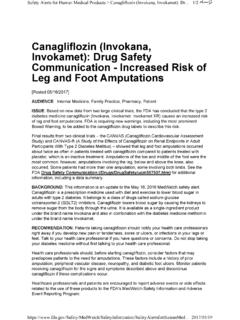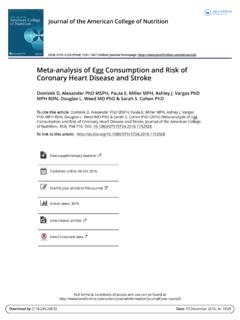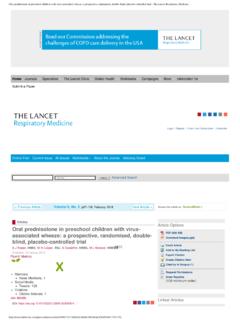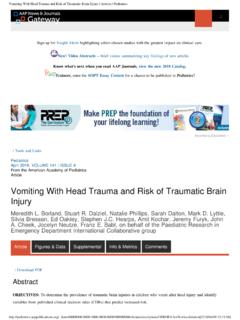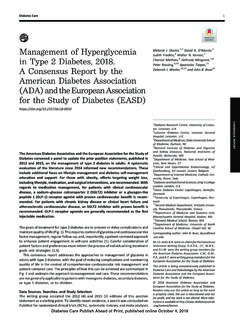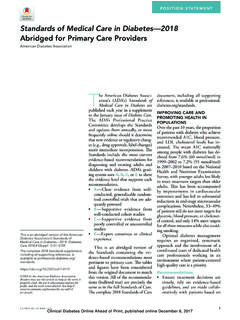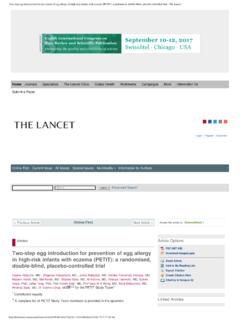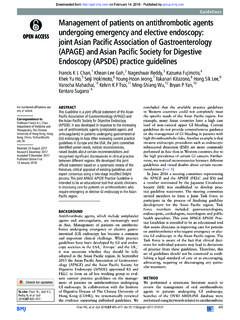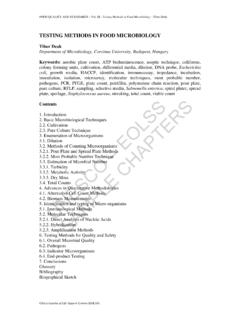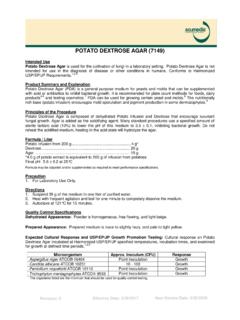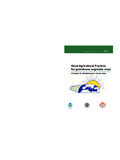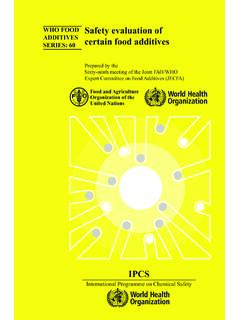Transcription of COMMENTARY E coli and Food Safety: It's a Jungle Out There
1 Adobe AudienceManager COMMENTARY . E coli and food safety : It's a Jungle Out There William F. Balistreri, MD. April 23, 2018. Foodborne illnesses are a substantial yet largely preventable health burden worldwide. We previously reviewed food safety in the United States[1] and harked back to the classic book, The Jungle , which portrayed the unsanitary conditions and practices prevalent in industrialized American cities in the early 1900s. [2] While this had a significant impact on reformation of the meatpacking industry, how far have we come since the conditions reported by Upton Sinclair? One indicator of progress is whether we have adequately responded to the lessons learned.
2 In this context, we will focus specifically on foodborne Escherichia coli infections. E coli Outbreaks and Renewed Efforts for safety In 1993, an E coli outbreak in four states affected more than 700 people and was associated with 171 hospitalizations, including four deaths in children, attributed to hemolytic-uremic syndrome (HUS); the common source of their illnesses was traced to Shiga toxin producing E coli (STEC) serogroup O157 contaminated hamburgers sold at Jack in the Box restaurants.[3,4]. This dramatic, widely publicized case series served to increase public awareness and concern about unsanitary practices in the fast- food industry.
3 [5] That outbreak, in part, spurred significant improvements in efforts to ensure safe food , including enhanced federal food safety regulations, more stringent industry practices, and intensified policies by the Centers for Disease Control and Prevention (CDC), the US Department of Agriculture (USDA), and the US food and Drug Administration (FDA). [6] This has been accompanied by advances in food science and by more rapid and precise pathogen detection, food monitoring, and surveillance. [7-9]. Key efforts to improve food safety have included the following [6] : E coli O157:H7 was declared an adulterant in ground beef, and other non-O157 STECs have been added to the list of adulterants.
4 E coli O157:H7 was raised to reportable disease status at all state health departments;. The CDC developed pulsed-field gel electrophoresis (PFGE) to detect and track bacterial isolates; PulseNet became the national molecular subtyping network for foodborne disease surveillance[8,10] ;. Research was undertaken to determine ways to reduce E coli in cattle and slaughterhouses;. Testing for E coli O157:H7 in ground beef was initiated;. Consumer education programs about potential dangers in ground beef and instructions for safe handling and optimal cooking were created;. The recommended temperature for cooking ground beef was increased by the FDA; and Safe production facilities via the USDA food safety and Inspection Service (FSIS) and the Hazard Analysis and Critical Control Point (HACCP) were ensured.
5 [11]. Infections caused by E coli serogroup O157 declined after targeted interventions to reduce contamination of ground beef were implemented. [8] So, where do we stand in regard to food safety policy and in the detection and prevention of illness due to E. coli in the United States? We will specifically review the history of infection due to STEC O157:H7; however, we will also discuss serogroups of STEC. other than serogroup O157 (eg, STEC O26:H11), which are highly pathogenic, capable of causing HUS, and have been associated with foodborne bacterial gastrointestinal illnesses and outbreaks in the United States. [9,12-14].
6 food safety Policy: Where Do We Stand? The Foodborne Diseases Active Surveillance Network (FoodNet) conducts active, population-based surveillance at 10 US. geographic areas sites for laboratory-confirmed infections commonly transmitted through food and monitors trends in enteric [2018/05/03 8:29:20]. Adobe AudienceManager illnesses and identifies their sources. According to FoodNet, the incidence of STEC O157 declined in 2014 compared with previous survey years. [13,15,16] However, despite ongoing food safety efforts, the incidence of infection remains high, indicating that further prevention measures are needed to make food safer and to achieve national health objectives.
7 Tracking Outbreaks To develop effective prevention measures, it is important to understand the percentage of foodborne illnesses associated with specific foods. Three federal agencies the CDC, the FDA, and the USDA-FSIS teamed up to create the Interagency food safety Analytics Collaboration (IFSAC). The goal is to improve coordination of federal food safety analytic efforts and to address cross-cutting priorities for food safety data collection, analysis, and use. [17] This includes foodborne illness source attribution (ie, approximating common food sources responsible for specific foodborne illnesses) and providing timely estimates of the food sources of four priority foodborne pathogens: Salmonella, E coli O157, Listeria monocytogenes, and Campylobacter.
8 A Cookie Monster Neil and colleagues [18] investigated a multistate outbreak of E coli O157:H7 infections in May 2009. Outbreak-associated cases were identified using serotyping and molecular subtyping procedures as well as traceback investigation and product testing. Ultimately, 77 patients with E coli infection were identified from 30 states; 35 were hospitalized and 10 developed HUS. Of note, 66% of affected persons were younger than 19 years and 71% were female. In a matched case-control study, 94% had consumed ready-to-bake commercial prepackaged raw cookie dough, compared with 11% of control subjects; no other reported exposures were significantly associated with this illness.
9 The FDA and the CDC notified the manufacturer of the investigation of this product in the reported E coli O157:H7 illnesses. The investigation led to a voluntary recall in June 2009 of million packages of cookie dough by Nestl USA, product reformulation, and institution of procedures to enhance quality-assurance protocols (eg, testing ingredients prior to use, rigorous environmental sampling).[19,20] This STEC outbreak associated with consuming uncooked ready-to-bake commercial prepackaged cookie dough also indicated the need for more effective consumer education about the risks of eating unbaked cookie dough. Recipe for Disaster?
10 One lingering issue in this outbreak was that the exact source and route of product contamination remained undetermined. However, in June 2016, the FDA, along with the CDC and state and local officials, investigated an outbreak of infections that once again illustrated the dangers of eating raw dough but this time they were able to more precisely pinpoint the source. This outbreak of STEC serogroup O121 and O26 infections was linked to contaminated flour.[21] Fifty-six cases were identified in 24 states. Univariable exact conditional logistic regression models found that one flour brand and the tasting of unbaked homemade batter or dough were significantly associated with infection.
